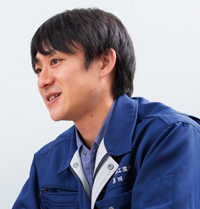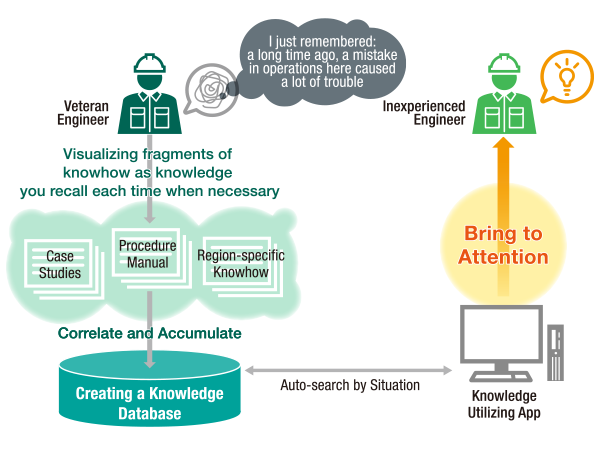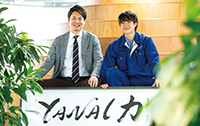YANAI ELECTRIC & MACHINERY Co., Ltd.
Phase 1 of constructing the knowledge base was creating a “vessel” for storing knowledge, while Phase 2 entailed making it possible to retrieve the accumulated knowledge automatically. Together with Mr. Harada, Mr. Shimada who was in charge of the technical aspects of the project explained the process.
“In Phase 1, we visualized the information we obtained via frequent site visits and the knowhow we garnered from interviews as knowledge, which we then incorporated as content. In Phase 2, we introduced an application that links this content with information on problems, and then displays knowledge on how to respond to the problems. One engineer who provided many kinds of knowhow gave us the feedback, ‘This will also help new engineers work more smoothly.’”
Although knowledge on how to respond to problems is displayed on the computer screen each time a problem occurs, Mr. Harada noted, “We took this opportunity to review deployment to reduce the number of dispatches as much as possible by prioritizing the response to alarms based on severity.” They also wanted to change the working methods of engineers who support the infrastructure of waterworks facilities.
“The maintenance and management of waterworks infrastructure produced certain ‘star’ engineers so specialized that ‘only that person can handle it.’ Since they could be called out 24 hours a day, 365 days a year, whenever a problem occurs, they never get a real break. Going forward, we have to avoid creating the need for such ‘star’ specialists. We think a system with a knowledge base at its foundation, which lets anyone respond, can also contribute to the well-being and quality of life for everyone,” said Mr. Harada. One result was that engineer overtime could be reduced to approximately 1/8 of what it was prior to introducing the system. What’ s more, Mr. Harada and Mr. Shimada are leading the push to automate processes to make work easier, and make it more efficient to use the knowledge base as a hub, using “no-code*” tools for developing IoT apps.


The Ministry of Health, Labour and Welfare is promoting broad-area collaboration beyond the borders of municipal areas in order to solve issues municipalities face with their waterworks.
Mr. Harada said, “As we look ahead to broad-area facility maintenance management, the knowledge base will be our strength and we intend to enrich the content to another level.”
The next step to deal with is collecting data on equipment and making predictions. Mr. Harada continued, “We are working with Hitachi Power Solutions on the introduction of the equipment diagnostic system C3-Edge and the predictive diagnostics system HiPAMPS. We collect data on equipment and determine what kind of maintenance can be performed in response to what symptoms to prevent breakdowns, as well as how to operate equipment to make it last longer. We will move forward step-by-step in automating areas that until now have been handled by people using their own wisdom. Automation is also becoming necessary in expanding the areas of waterworks business.”
They are also looking to expand business further from a maintenance perspective. “Since we are involved in water infrastructure, we see other infrastructure that isn’t being maintained. I think they are parts of deteriorating infrastructure we can inspect and thus protect the community, such as bridges that carry water pipes, small tunnels, and so on. The knowledge base will definitely be useful at such times,” said Mr. Harada.
Hitachi Power Solutions applies its technology-backed proposal capabilities to provide what operators want, so they can move forward with momentum into the next step in the infrastructure Maintenance business.

YANAI ELECTRIC & MACHINERY Co., Ltd.
Teal Facilities Co., Ltd.